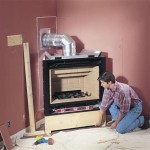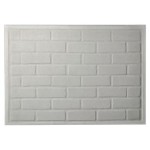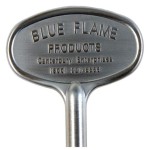Simple Wood Fireplace Mantel Designs
The fireplace often serves as a focal point within a room, drawing attention and contributing significantly to the overall ambiance and aesthetic appeal. While the fire itself is a key element, the mantel acts as a decorative shelf and architectural accent, framing the firebox and providing a surface for displaying personal items. A well-chosen mantel can complement the existing décor and enhance the perceived value of the home. Simple wood fireplace mantel designs offer a versatile and cost-effective way to achieve a refined and personalized look.
Wood, as a material, provides warmth and natural beauty that resonates well with various interior design styles, from rustic to modern. The simplicity of a wooden mantel lies in its clean lines, unadorned surfaces, and the inherent character of the wood grain. These designs prioritize functionality and understated elegance, allowing the fire and surrounding elements to take center stage. Furthermore, simple wood mantels are often more approachable for do-it-yourself projects, reducing installation costs and allowing for greater customization options.
Selecting an appropriate wood species is a crucial aspect of the design process. The choice should consider factors such as the desired aesthetic, durability, and budget. Softwoods like pine and fir are typically more affordable and easier to work with, but may be more susceptible to dents and scratches. Hardwoods such as oak, maple, and cherry offer greater durability and a richer appearance, but come at a higher cost. The wood’s grain pattern also plays a significant role in the overall look, with some species exhibiting prominent patterns that add visual interest and others offering a more uniform appearance.
Considerations extend beyond the species of wood to include the finish applied. The finish not only protects the wood from moisture and wear but also significantly impacts its color and texture. Staining can enhance the natural grain and color of the wood, while painting offers a wider range of color options and can create a more modern or contemporary look. Clear finishes, such as polyurethane or varnish, protect the wood while allowing its natural beauty to shine through. The chosen finish should complement the existing décor and withstand the heat generated by the fireplace.
The size and proportions of the mantel are also significant design elements. The mantel should be sized appropriately for the scale of the fireplace and the surrounding room. A mantel that is too small may appear insignificant, while one that is too large can overwhelm the space. The depth of the mantel shelf should be sufficient to accommodate decorative items without appearing cluttered or unsafe. The height of the mantel above the firebox is also crucial, as it must comply with local building codes and safety regulations to prevent the wood from overheating. These regulations vary depending on the type of fireplace and the combustible nature of the surrounding materials.
Key Point 1: Design Considerations for Simple Wood Mantels
The design of a simple wood fireplace mantel hinges on several key factors that contribute to its overall aesthetic and functionality. These considerations guide the selection of materials, dimensions, and finishing techniques to create a cohesive and harmonious element within the room.
One crucial aspect is the architectural style of the home. A simple wood mantel can be adapted to complement various styles, from traditional to contemporary. In a traditional setting, a mantel with subtle moldings and a stained finish might be appropriate. In a modern setting, a sleek, minimalist mantel with clean lines and a painted finish may be more suitable. The design should integrate seamlessly with the existing architectural details and create a sense of visual unity.
The dimensions of the fireplace and surrounding wall space also play a critical role in determining the mantel’s size and proportions. The mantel should be centered above the firebox and sized to complement the overall scale of the fireplace. A rule of thumb is to ensure that the mantel shelf extends slightly beyond the width of the firebox opening on each side. The height of the mantel should also be appropriate for the ceiling height and the overall proportions of the room. A mantel that is too low can appear cramped, while one that is too high can feel disconnected from the fireplace.
The functionality of the mantel is another important consideration. While serving as a decorative element, the mantel also provides a surface for displaying personal items such as photographs, artwork, and collectibles. The depth of the mantel shelf should be sufficient to accommodate these items without appearing cluttered. The weight-bearing capacity of the mantel should also be considered, especially if heavier items are to be displayed. Reinforcing the mantel with sturdy brackets or supports may be necessary to ensure its stability and prevent sagging.
Finally, the safety of the mantel must be taken into account. The mantel should be installed at a safe distance from the firebox to prevent the wood from overheating and potentially catching fire. Local building codes and safety regulations specify minimum distances between the mantel and the firebox, depending on the type of fireplace and the combustible nature of the surrounding materials. It is essential to consult these codes and regulations before installing a mantel to ensure compliance and prevent hazardous situations.
Key Point 2: Installation Techniques and Best Practices
The installation of a simple wood fireplace mantel requires careful planning and execution to ensure its stability, safety, and aesthetic appeal. Proper installation techniques are essential for achieving a professional-looking result and preventing potential hazards. Before commencing the installation process, it is crucial to gather the necessary tools and materials, including a level, measuring tape, drill, screws, wood glue, and safety glasses.
The first step in the installation process is to accurately measure and mark the desired location of the mantel on the wall. The mantel should be centered above the firebox and positioned at the appropriate height, taking into account local building codes and safety regulations. It is important to use a level to ensure that the markings are straight and that the mantel will be installed horizontally.
Once the location of the mantel has been marked, the next step is to prepare the wall for installation. This may involve locating and marking the positions of wall studs, which will provide a secure anchor for the mantel. A stud finder can be used to locate the studs behind the drywall or plaster. If the wall is made of brick or stone, it may be necessary to drill pilot holes and use masonry anchors to provide a stable attachment point.
The mantel itself can be attached to the wall using various methods, depending on its size, weight, and design. For smaller mantels, wood screws may be sufficient to secure the mantel to the wall studs. For larger or heavier mantels, it may be necessary to use metal brackets or supports to provide additional stability. Wood glue can also be used to bond the mantel to the wall, providing a stronger and more permanent connection. When using wood glue, it is important to clamp the mantel in place until the glue has fully dried.
After the mantel has been securely attached to the wall, the final step is to fill any gaps or imperfections with wood filler and sand the surface smooth. The mantel can then be finished with paint, stain, or a clear coat to protect the wood and enhance its appearance. It is important to follow the manufacturer's instructions for applying the chosen finish.
Key Point 3: Maintenance and Care of Wood Mantels
Proper maintenance and care are essential for preserving the beauty and longevity of a wood fireplace mantel. Regular cleaning and preventative measures can help to protect the wood from damage and maintain its aesthetic appeal over time. The specific maintenance requirements will vary depending on the type of wood, the finish applied, and the surrounding environment.
Regular cleaning is crucial for removing dust, dirt, and grime that can accumulate on the surface of the mantel. A soft cloth or duster can be used to gently wipe the mantel on a regular basis. For more stubborn stains or dirt, a mild soap and water solution can be used, but it is important to avoid using harsh chemicals or abrasive cleaners, as these can damage the finish. After cleaning, the mantel should be thoroughly dried with a clean cloth.
Protecting the wood from moisture is also essential. Excessive moisture can cause the wood to warp, crack, or rot. It is important to avoid placing wet or damp items directly on the mantel. If spills occur, they should be wiped up immediately. In humid environments, a dehumidifier can be used to reduce the moisture content of the air.
The finish on the mantel also requires regular maintenance. Depending on the type of finish, it may be necessary to reapply a protective coat every few years. For example, a wax finish may need to be reapplied more frequently than a polyurethane finish. It is important to follow the manufacturer's instructions for maintaining the chosen finish.
Finally, it is important to protect the mantel from excessive heat. While mantels are designed to withstand the heat generated by the fireplace, prolonged exposure to high temperatures can cause the wood to dry out and crack. It is important to ensure that the mantel is installed at a safe distance from the firebox and that the fireplace is used according to the manufacturer's instructions. Avoid placing flammable materials directly on the mantel.
By implementing these maintenance and care practices, homeowners can ensure that their simple wood fireplace mantel remains a beautiful and functional focal point for years to come. These preventative measures contribute to the long-term preservation of the wood and maintain its aesthetic appeal.

Collection Of Premium Wood Fireplace Mantels Dogberry

53 Best Fireplace Mantel Designs To Ignite Your Creativity Classic White Mantels Living Room With
:max_bytes(150000):strip_icc()/sandandsisal-bdc76ad938a44d28ae9e23ef6c9fa331.jpg?strip=all)
17 Diy Fireplace Mantel Plans

Simple European Farmhouse Barn Beam Fireplace Mantel Makeover Open Doors Hearts

How To Make An Easy Diy Fireplace Mantel Sprucing Up Mamahood

35 Fireplace Mantel Ideas For A Heavenly Hearth Bored Panda

Fireplace Design Ideas Materials Colors Styles In 2024 Bodaq

Simple Summer Fireplace Mantel Savvy Apron

30 Tips To Diy And Decorate Your Fireplace Mantel Shelf Wood Simple

Diy Wood Mantel Simple To Make Artsy Rule
Related Posts








